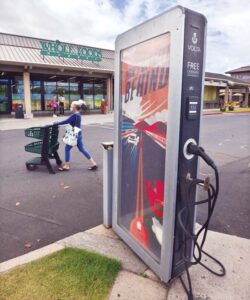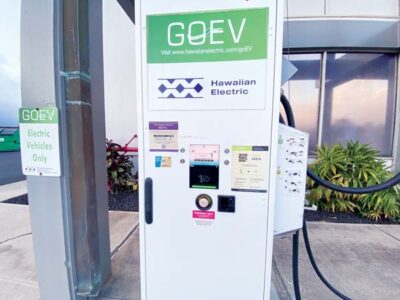Charging stations planned for county amid EV push
New federal program aims to increase access to chargers for electric vehicles
Maui County is set to receive four electric vehicle charging stations in the next five years as the state pushes to meet a zero emissions clean energy economy by 2045.
Eleven electric vehicle charging stations are to be installed in Hawaii as part of the new National Electric Vehicle Infrastructure program, including two on Maui in Wailuku and Hana, one on Lanai in Lanai City, one on Molokai in Kaunakakai, one each on Oahu and Kauai, and the remaining five on Hawaii island.
The federal program sets a standard for electric vehicle infrastructure for all states, and the first phase requires that one DC fast charger must be installed at 50-mile intervals along and within one mile of all Hawaii’s highways, said state Department of Transportation Special Projects Manager Dre Kalili on Monday afternoon.
DOT expects about $6.1 million in funding in the first two years of the five-year program. Each station is about $1.5 million, according to the NEVI Hawaii State Plan, which is subject to approval by the federal Joint Office of Energy and Transportation.
The goal is to install a reliable and convenient network of fast chargers for electric vehicles across the state, DOT Deputy Director for Highways Ed Sniffen noted. And, a key part of the plan is making sure that the chargers are strategically placed so they are accessible to the community and in safe places.
The department is still deciding on affordable rates for customers, Sniffen said.
The chargers will be able to provide a full charge to four cars simultaneously within 20 minutes, Kalili said.
The department is excited about this clean energy plan “but we have a lot of work ahead of us” to ensure that residents have access to alternative fuel corridors statewide, she added.
Once the 11 chargers are in place for phase one, Kalili said that DOT will update its plan to add charging stations to other corridors in community locations “that make better sense” in order to “fill the gaps.”
In particular, DOT is looking to install a single fast charging station in Wailuku in a park-and-ride lot owned and controlled by the department. This location is within 50 miles of all but one alternative fuel corridor on the island.
In rural communities, like Hana, where power availability is limited due to having a smaller grid capacity, DOT will seek exemptions of the 50-mile rule and deploy Level 2 chargers, which can range from four to eight hours of charging time, to meet the demands of that area.
On the islands of Molokai and Lanai, DOT plans to install Level 2 charging stations to meet the charging demands instead of using a 600-kilowatt fast charging station, according to the NEVI Hawaii State Plan.
Molokai, with a population of 7,345, cannot support a 600-kW charging station — that would require nearly one-third of the island’s current power demand, the report said.
Since DC fast chargers are a priority, identifying specific locations for Level 2 infrastructure and installing them may be toward the end of the five-year plan.
Scott Glenn, Hawaii chief energy officer, said the main goal is to address the “charging anxiety” as more and more residents purchase electric vehicles and look for places to reboot.
“We want to make sure to give them reliant access to charging,” said Glenn, adding that installing the first 11 stations will be a key major step.
According to the state Department of Business, Economic Development and Tourism Monthly Energy Trends report for June, there were 19,914 electric vehicles among 1,055,356 registered vehicles.
In 2018, Hawaiian Electric Company projected in its Electrification of Transportation Strategic Roadmap that by 2045, 55 percent of personal light-duty vehicles operated in the state would be electric and that a minimum of 2,200 public charging ports would be needed to meet the demand for charging.
As of July 1, there were 368 electric vehicle charging locations and 805 electric vehicle supply equipment ports that provide DC fast or Level 2 charging across the state, according to the NEVI state plan.
On Maui, the majority of charging infrastructure is located in the central, west and south sides of the island.
The NEVI plan outlines three primary risks in the deployment of electric vehicle infrastructure: power availability, supply chain management and labor shortages, and site control.
Still, Glenn said that DOT has collaborated with various agencies since 2016 to collect information and understand rates of electric vehicle adoption, progress in electrification of transportation, demand for charging facilities in Hawaii, feasibility of infrastructure deployment under the NEVI requirements and development of a five-year project timeline.
DOT will prioritize state- and county-owned sites to house the 11 charging stations as the department plans to secure permits and begin installation work for the first DC fast charging stations this winter.
“As we go through the permitting and construction process the first site selected will be the one we can build out the fastest, so likely one on state or county property,” DOT spokeswoman Shelly Kunishige said in an email. “Our goal is to begin construction of the first site in December, pending availability of the NEVI compliant chargers. There will be community outreach before construction begins.”
* Dakota Grossman can be reached at dgrossman@mauinews.com.
- A Volta electric vehicle charger sits in front of Whole Foods in Kahului in June 2021. The state is planning to install more 11 chargers across the state, including four in Maui County, under a new federal program that sets requirements for electric vehicle charging access for all states. The Maui News / MATTHEW THAYER photo
- An electric vehicle charger is seen outside Hawaiian Electric in Kahului in March. The Maui News / COLLEEN UECHI photo



